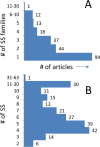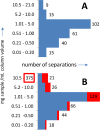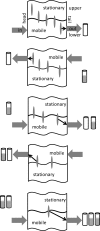Countercurrent Separation of Natural Products: An Update
- PMID: 26177360
- PMCID: PMC4517501
- DOI: 10.1021/np501065h
Countercurrent Separation of Natural Products: An Update
Abstract
This work assesses the current instrumentation, method development, and applications in countercurrent chromatography (CCC) and centrifugal partition chromatography (CPC), collectively referred to as countercurrent separation (CCS). The article provides a critical review of the CCS literature from 2007 since our last review (J. Nat. Prod. 2008, 71, 1489-1508), with a special emphasis on the applications of CCS in natural products research. The current state of CCS is reviewed in regard to three continuing topics (instrumentation, solvent system development, theory) and three new topics (optimization of parameters, workflow, bioactivity applications). The goals of this review are to deliver the necessary background with references for an up-to-date perspective of CCS, to point out its potential for the natural product scientist, and thereby to induce new applications in natural product chemistry, metabolome, and drug discovery research involving organisms from terrestrial and marine sources.
Figures







Similar articles
-
Countercurrent separation of natural products.J Nat Prod. 2008 Aug;71(8):1489-508. doi: 10.1021/np800144q. Epub 2008 Jul 31. J Nat Prod. 2008. PMID: 18666799 Review.
-
Solvent System Selection Strategies in Countercurrent Separation.Planta Med. 2015 Nov;81(17):1582-91. doi: 10.1055/s-0035-1546246. Epub 2015 Sep 21. Planta Med. 2015. PMID: 26393937 Free PMC article. Review.
-
The 9th International Countercurrent Chromatography Conference held at Dominican University, Chicago, USA, August 1-3, 2016.J Chromatogr A. 2017 Oct 20;1520:1-8. doi: 10.1016/j.chroma.2017.08.077. Epub 2017 Sep 19. J Chromatogr A. 2017. PMID: 28939232
-
Online hyphenation of centrifugal partition chromatography with countercurrent chromatography (CPC-CCC) and its application to the separation of saturated alkylresorcinols.Anal Bioanal Chem. 2022 Jul;414(17):5043-5051. doi: 10.1007/s00216-022-04136-x. Epub 2022 May 31. Anal Bioanal Chem. 2022. PMID: 35639138 Free PMC article.
-
A comprehensive classification of solvent systems used for natural product purifications in countercurrent and centrifugal partition chromatography.Nat Prod Rep. 2015 Nov;32(11):1556-61. doi: 10.1039/c5np00061k. Nat Prod Rep. 2015. PMID: 26219437 Review.
Cited by
-
Isoquinoline Alkaloids from Coptis chinensis Franch: Focus on Coptisine as a Potential Therapeutic Candidate against Gastric Cancer Cells.Int J Mol Sci. 2022 Sep 7;23(18):10330. doi: 10.3390/ijms231810330. Int J Mol Sci. 2022. PMID: 36142236 Free PMC article.
-
Residual Complexity Does Impact Organic Chemistry and Drug Discovery: The Case of Rufomyazine and Rufomycin.J Org Chem. 2018 Jun 15;83(12):6664-6672. doi: 10.1021/acs.joc.8b00988. Epub 2018 May 24. J Org Chem. 2018. PMID: 29792329 Free PMC article.
-
Effective isolation of cannabidiol and cannabidiolic acid free of psychotropic phytocannabinoids from hemp extract by fast centrifugal partition chromatography.Anal Bioanal Chem. 2023 Aug;415(19):4827-4837. doi: 10.1007/s00216-023-04782-9. Epub 2023 Jun 29. Anal Bioanal Chem. 2023. PMID: 37382652 Free PMC article.
-
In vitro human cell-based TTR-TRβ CALUX assay indicates thyroid hormone transport disruption of short-chain, medium-chain, and long-chain chlorinated paraffins.Arch Toxicol. 2021 Apr;95(4):1391-1396. doi: 10.1007/s00204-021-02994-5. Epub 2021 Feb 8. Arch Toxicol. 2021. PMID: 33555371 Free PMC article.
-
Efficient Isolation of Mycosporine-Like Amino Acids from Marine Red Algae by Fast Centrifugal Partition Chromatography.Mar Drugs. 2022 Jan 27;20(2):106. doi: 10.3390/md20020106. Mar Drugs. 2022. PMID: 35200636 Free PMC article.
References
-
- Schindler H. J. Chem. Educ. 1957, 34, 528.10.1021/ed034p528. - DOI
-
- Craig L. C. J. Biol. Chem. 1944, 155, 519–534.
-
- Harfenist E. J. C.; Lyman C. J. Am. Chem. Soc. 1951, 73, 877–878.
-
- Berthod A.Countercurrent Chromatography: The Support-Free Liquid Phase; Elsevier: Amsterdam, 2002.
Publication types
MeSH terms
Substances
Grants and funding
LinkOut - more resources
Full Text Sources
Other Literature Sources

